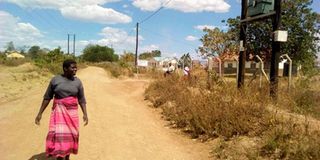Rural power supply lights up Teso

Connected. Electricity transmission lines connected to Tubur Health Centre III in Soroti District. The rural electrification programme, which was extended to Teso Sub-region in 2015, has changed the face of the region. PHOTO BY GEORGE MURON
What you need to know:
- Call. Local leaders have urged government to subsidise the electricity since its aim is to ensure all rural areas are connected to the national grid.
Teso. With majority of schools and health centres in rural areas in Teso Sub-region operating without electricity, government rolled out the rural electrification programme across the country to ease service delivery.
In 2015, through the Rural Electrification Agency (REA), several government and private facilities in the sub-region have benefited but users have called for a reduction of power tariffs.
In Tubur Sub-county in Soroti District, a network of electricity wires connected to the national grid runs through its headquarters, Tubur Health Centre III, Tubur Senior Secondary and a couple of businesses engaged in wielding and selling beverages have been boosted.
Mr Sam Ebaju, the sub-county secretary for health and education, said the health facility has eased the burden of midwives helping mothers deliver.
“It is a good initiative, but government should reduce its charges on power tariffs, especially in rural areas since its objective was to make power accessible to rural communities that are still struggling to get rid of sources of light that emit excess carbon,” Mr Ebaju said.
Ms Gladys Akello, a bar proprietor in Tubur Trading Centre, said ever since she was connected on the grid, she incurs more costs.
“We used to pay Shs600 per unit now we are paying Shs1,000 for each unit consumed, that is a lot of money, this should be reduced to Shs300,” she said.
Mr Charles Aleper, the district councillor for Katakwi, said they no longer experience power shortages.
“Prior to this, sounds of rumbling generators from morning was something we had become accustomed to, now this only happens when power on the national grid is off,” he said.
Mr Aleper said since it is rural electrification, it should be made consumer-friendly to low-income earners who wish to use power, adding that because of the high power bills, most residents who have power under REA passing through their areas have feared to tap it.
He said government institutions also incur high bills.
“All public institutions such as schools and health centres should have free power or it should be subsidised by government,” he said.
Mr Hanns Paul Kyazze, the communications officer at the Ministry of Energy and Mineral Development, said their aim is to rid rural communities from using dangerous sources of lighting and have all public institutions connected to the grid.
He said the $200m project is a government plan aimed at having all key rural settings powered in the next five years, as mechanism to ease service delivery, communication and empower rural innovativeness through use of power to add value to commodities produced at the rural areas.
Dr Patricia Litho, the REA spokesperson, said 50Km of rural areas have been connected to the grid in Soroti under World Bank funding, with 0.4Km covering areas of Katine-Lwala, Oimai to Soroti University.
She said in Serere District, 45km of rural areas have been connected to power, including Kateta, Omunyolo, Kamod SS, Serere Apapai, Kidetok, Pingire and Bugondo areas.
Other districts connected to power under the REA project are Ngora (27Km), Kaberamaido (40Km) and Bukedea (58Km).
BACKGROUND
In April last year, government, through the Rural Electrification Agency announced that it will, with effect from June, roll out a free electricity connection policy, aimed at increasing the percentage of the rural population accessing electricity.
The 10-year $700 (Shs2.6 trillion) will see at least three million new customers connected to the on and off grid power across the country at no costs.




